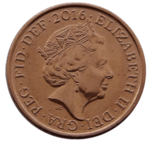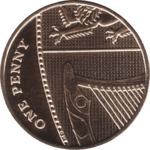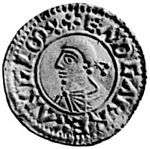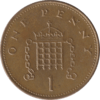Penny (British decimal coin)
The British decimal one penny (1p) coin is a unit of currency equalling one-hundredth of a pound sterling. Its obverse has featured the profile of Queen Elizabeth II since the coin's introduction on 15 February 1971, the day British currency was decimalised. Four different portraits of the Queen have been used on the obverse; the latest design by Jody Clark was introduced in 2015. The second and current reverse, designed by Matthew Dent, features a segment of the Royal Shield and was introduced in 2008.[1] The penny is the lowest value coin (in real terms) ever to circulate in the United Kingdom.
United Kingdom | |
| Value | 0.01 pound sterling |
|---|---|
| Mass | 3.56 g |
| Diameter | 20.3 mm |
| Thickness | (Bronze) 1.52 mm (Steel) 1.65 mm |
| Edge | Plain |
| Composition | Bronze (1971–1991) Copper-plated steel (1992–) |
| Years of minting | 1971–present |
| Obverse | |
 | |
| Design | Queen Elizabeth II |
| Designer | Jody Clark |
| Design date | 2015 |
| Reverse | |
 | |
| Design | Segment of the Royal Shield |
| Designer | Matthew Dent |
| Design date | 2008 |
The penny was originally minted from bronze, but since 1992 has been minted in copper-plated steel due to increasing copper prices.
There are an estimated 10.5 billion 1p coins in circulation as of 2016, with a total face value of around £105,000,000.
1p coins are legal tender for amounts only up to the sum of 20p when offered in repayment of a debt; however, the coin's legal tender status is not normally relevant for everyday transactions.
Etymology
The word penny is derived from the Old English word penig, which itself comes from the proto-Germanic panninga.[2] The correct plural form for multiple penny coins is pennies (e.g. fifty pennies). The correct term for monetary amounts of pennies greater than one penny is pence (e.g. one pound and twenty pence).[3]
History
Prior to 1971, the United Kingdom had been using the pounds, shilling and pence currency system. Decimalisation was announced by Chancellor James Callaghan on 1 March 1966; one pound would be subdivided into 100 pence, instead of 240 pence as previously was the case.[4]
This required new coins to be minted, to replace the pre-decimal ones.[5][6] The original specification for the 1p coin was set out in the Decimal Currency Act 1969, which was replaced by the Currency Act 1971. Both mandated the weight of the coin to be 3.564 grammes ±0.000005g, and 2.032 cm ±0.00005 cm in diameter.[7] Subsequently, the Currency Act 1983 allows for the standards of the 1p coin to be changed by Royal Proclamation.[8]
The new 1p coins began production in December 1968 in the newly built Royal Mint facility in Llantrisant, South Wales. 1,521,666,250 1p coins were minted between 1968 and the end of 1971.[9] On 15 February 1971, the United Kingdom officially switched to a decimal currency and the new coins entered circulation.[10] The coins continue to be minted at this facility today.[11]
Metallic composition
The coin was originally minted in bronze (composition 97% copper, 2.5% zinc, 0.5% tin) between 1971 and September 1992. However, increasing world metal prices necessitated a change of composition. Since 1992, the coins are minted in steel and electroplated in copper, making them magnetic.[12] Rising world prices for copper had caused the metal value of the pre-1992 copper 1p coin to exceed 1p. For example, in May 2006, the intrinsic metal value of a pre-1992 1p coin was about 1.5 pence.[13] However, melting coins is illegal in the United Kingdom and is punishable by a fine, or up to 2 years imprisonment.[14][15]
| This article is part of a series on the |
| History of the English penny |
|---|
 |
|
Obverse designs
To date, four different obverses have been used, all of which feature a portrait of Queen Elizabeth II. The outer inscription on the coin is ELIZABETH II D.G.REG.F.D. 2013,[16] where 2013 is replaced by the year of minting. In the original design both sides of the coin are encircled by dots, a common feature on coins, known as beading.
Anticipation of a switch to a decimalised currency led to the commissioning of a new Royal Portrait by artist Arnold Machin, which was approved by the Queen in 1964.[17] This featured the Queen wearing the 'Girls of Great Britain and Ireland' Tiara and was used until 1984.[12] A modified form of this portrait has appeared on British Postage stamps since 1967.[18]
Between 1985 and 1997 a portrait by Raphael Maklouf was used.[12] The portrait is couped, and depicts the Queen wearing the George IV State Diadem. Unlike previous portraits, the Queen is wearing jewellery, earrings and a necklace. The initials of Maklouf RDM are shown below the neck of the Queen. His middle name, David, is included so that the mark is not confused with the initials of the Royal Mint.[18]
In 1997, a competition to design the obverse of the 1997 Golden Wedding crown – a coin issued to celebrate the Queen's and Prince Philip's 50th wedding anniversary – was held. The standard of entry was so high that following this competition, the Royal Mint held another to design the new portrait.[19] Ian Rank-Broadley won this competition, and his design was used between 1998 and 2015.[12] His design again featured the tiara, with a signature-mark IRB below the portrait.[20] The depiction of the Queen was seen as more realistic, with Rank Broadley himself saying "There is no need to flatter her. She is a 70-year-old woman with poise and bearing".[18]

In 2014, the Royal Mint again held a competition to design a new portrait.[21] Designer Jody Clark won this competition, with a portrait of the Queen wearing the George IV State Diadem and the initials JC feature under the neck of the Queen.[12][18] The portrait was sketched without an official sitting, only using reference material for inspiration.[21]
Reverse designs
Despite no official government confirmation of a switch to decimalised currency, the Royal Mint began the design process for decimal coins in 1962. They invited the Royal Academy, the Royal Institute of British Architects, the Faculty of the Royal Designers for Industry and the Royal College of Art to nominate artists to design the hypothetical new coins. British sculptor Christopher Ironside won this competition, and his design was chosen to feature on the potential decimalised currency. His design for the 1p coin featured a Scottish theme, with a coin depicting a thistle above a Scottish flag inside a shield and a Scottish lion inside a shield.[22] However, Chancellor James Callaghan's announcement that the United Kingdom would decimalise its currency included an open competition to find the new designs. Over 80 artists and 900 different designs were submitted.[17] Ironside entered this competition with a further, different style of designs and won.[22][23]
The reverse of the coin, which was minted from 1971 to 2008, featured a crowned portcullis with chains (an adaptation of the Badge of Henry VII which is now the Badge of the Palace of Westminster), with the numeral "1" written below the portcullis, and either NEW PENNY (1971–1981) or ONE PENNY (1982–2008) above the portcullis.[12]
In August 2005 the Royal Mint launched a competition to find new reverse designs for all circulating coins apart from the £2 coin.[24] The winner, announced in April 2008, was Matthew Dent, whose designs were gradually introduced into circulating British coinage from mid-2008.[25] The designs for the 1p, 2p, 5p, 10p, 20p and 50p coins depict sections of the Royal Shield that form much of the whole shield when placed together. The entire shield was featured on the now-obsolete round £1 coin.[26] The 1p coin depicts the left section between the first and third quarter of the shield, representing England and Northern Ireland. The coin's obverse remains largely unchanged, but the beading (the ring of dots around the coin's circumference), which no longer features on the coin's reverse, has also been removed from the obverse.[27]
Status
Legal tender
1p coins are legal tender for amounts up to and including 20 pence.[28][29] However, in the UK, "legal tender" has a very specific and narrow meaning which relates only to the repayment of debt to a creditor, not to everyday shopping or other transactions.[30] Specifically, coins of particular denominations are said to be "legal tender" when a creditor must by law accept them in redemption of a debt.[31] The term does not mean - as is often thought - that a shopkeeper has to accept a particular type of currency in payment.[30] A shopkeeper is under no obligation to accept any specific type of payment, whether legal tender or not; conversely they have the discretion to accept any payment type they wish.[29]
Speculation on withdrawal
The proposed withdrawal of the 1p coins has been subject of media speculation, such as in 2015 when the Chancellor of the Exchequer, George Osborne, proposed the withdrawal of the 1p coin. This was vetoed by Prime Minister David Cameron, because of the potential unpopularity with the public.[32]
In March 2018, the Government launched a consultation on the future of payments in the British economy. One question focused on the denominational mix of coins, including 'dormant' denominations.[33] This prompted speculation that the 1p and 2p coins could be withdrawn from circulation.[34][35] Analysis from staff at the Bank of England concluded that fears about the withdrawal were 'unfounded' and that there would be no significant impact on prices if copper coins were scrapped, noting the sharp decline in usage of copper coins. It is estimated that 60% of copper coins are only spent once, before being removed from the cash cycle, as they are saved or binned. Approximately 8% of 1p coins are estimated to be thrown away entirely, requiring the annual minting of new 1p and 2p coins with a face value of £500m to replace coins falling out of circulation.[36] Further, potential inflationary effects from the rounding of prices caused by scrapping the 1p would likely be minimal, given only 3% of payments by value are made in cash and card payments would continue to be made unrounded.[37]
There was concern raised by some charities and businesses over the scrapping of 1p coins. Charities feared that the number of donations made in collection pots would fall and some business models could be severely impacted, for example traditional seaside arcades.[38][39] However, in May 2019 Chancellor Phillip Hammond announced the outcome of a 2018 consultation, suggesting there were no plans to scrap copper coins and that he wanted the public to 'have choice over how they spend their money'.[40][41] No 1p coins were minted in 2018, as the Treasury said that there were already enough in circulation.[42][43]
Value
The penny has the lowest value in real terms of any coin in the history of the United Kingdom, since at least 1707. All previous low-value coins were withdrawn before their purchasing power fell below that of the penny.[44] The purchasing power of previous lowest-value coins is:
| Coin | Face value Fraction of £1 |
Withdrawn | 2019 equivalent purchasing power at withdrawal[45] |
|---|---|---|---|
| Half farthing | 1⁄1920 | 1869/1870 | 5p |
| Farthing | 1⁄960 | 1960 | 2.4p |
| Pre-decimal halfpenny | 1⁄480 | 1969 | 3.5p |
| Pre-decimal penny | 1⁄240 | 1971 | 5.9p |
| Decimal halfpenny | 1⁄200 | 1984 | 1.6p |
Mintages
Machin portrait
- 1971 ~ 1,521,666,250
- 1972 ~ In proof sets only
- 1973 ~ 280,196,000
- 1974 ~ 330,892,000
- 1975 ~ 221,604,000
- 1976 ~ 300,160,000
- 1977 ~ 285,430,000
- 1978 ~ 292,770,000
- 1979 ~ 459,000,000
- 1980 ~ 416,304,000
- 1981 ~ 301,800,000
- 1982 ~ 100,292,000
- 1983 ~ 243,002,000
- 1984 ~ 154,759,625
Maklouf portrait
- 1985 ~ 200,605,245
- 1986 ~ 369,989,130
- 1987 ~ 499,946,000
- 1988 ~ 793,492,000
- 1989 ~ 658,142,000
- 1990 ~ 529,047,500
- 1991 ~ 206,457,600
composition changed to copper-plated steel
- 1992 ~ 253,867,000
- 1993 ~ 602,590,000
- 1994 ~ 843,834,000
- 1995 ~ 303,314,000
- 1996 ~ 723,840,060
- 1997 ~ 396,874,000
Rank-Broadley portrait
- 1998 ~ 739,770,000
- 1999 ~ 891,392,000
- 2000 ~ 1,060,420,000
- 2001 ~ 928,698,000
- 2002 ~ 601,446,000
- 2003 ~ 539,436,000
- 2004 ~ 739,764,000
- 2005 ~ 536,318,000
- 2006 ~ 524,605,000
- 2007 ~ 548,002,000
- 2008 ~ 180,600,000 (Ironside reverse)
- 2008 ~ 507,952,000 (Dent reverse hereafter)
- 2009 ~ 556,412,800
- 2010 ~ 609,603,000
- 2011 ~ 431,004,000
- 2012 ~ 227,201,000
- 2013 ~ 260,800,000
- 2014 ~ 464,801,520
- 2015 ~ 154,600,000
Clark portrait
- 2015 ~ 418,201,016
- 2016 ~ 368,482,000
- 2017 ~ 240,999,600
- 2018 ~ In proof sets only
Data taken from the Royal Mint mintage statistics.[9] The latest estimate from the Royal Mint of the total number of 1p coins in circulation was in March 2016 and there were an estimated 10.5 billion 1p coins in circulation, with a total face value of around £105,000,000.[42]
See also
- History of the British penny (1714–1901)
- History of the British penny (1901–1970)
References
- "One Penny Coin". Royal Mint. Retrieved 2020-03-29.
- "penny | Origin and meaning of penny by Online Etymology Dictionary". www.etymonline.com. Retrieved 2019-05-06.
- "pence | Definition of pence in English by Lexico". Lexico English. Retrieved 2019-09-03.
- James Callaghan, Chancellor of the Exchequer (1 March 1966). "Economic Situation". Parliamentary Debates (Hansard). United Kingdom: House of Commons. col. 1120.
- Freeman, Len (2011-02-05). "What's that in old money?". BBC News. Retrieved 2019-05-12.
- "The Royal Mint and decimalisation | The Royal Mint". www.royalmint.com. Retrieved 2019-05-12.
- "Coinage Act: Section Schedule/1/enacted", legislation.gov.uk, The National Archives, 1971 c. 24 (s. Schedule/1/enacted)
- "Currency Act: Section 1", legislation.gov.uk, The National Archives, 1983 c. 9 (s. 1)
- "Mintage Figures". Royal Mint. Archived from the original on 28 August 2018. Retrieved 28 December 2015.
- "All Change: Decimalisation". Royal Mint Museum. Retrieved 2019-05-12.
- "Making the coins in your pocket | The Royal Mint". www.royalmint.com. Retrieved 2019-05-06.
- "One Penny Coin | The Royal Mint". www.royalmint.com. Retrieved 2019-05-05.
- Your small fortune: 2p coins that could be worth 3p each, Telegraph, 12 May 2006
- "Destroying Coinage | The Royal Mint". www.royalmint.com. Retrieved 2019-05-09.
- "Coinage Act: Section 10", legislation.gov.uk, The National Archives, 1971 c. 24 (s. 10)
- Clayton, Tony. "Decimal Coins of the UK – Bronze". Tony Clayton. Retrieved 2006-05-24.
- "All Change Decimalisation". Royal Mint Museum. Retrieved 2019-05-12.
- "The five portraits of Her Majesty The Queen". www.royalmint.com. Retrieved 2019-05-11.
- "Coins to get new Queen's head". BBC News. 2014-11-06. Retrieved 2019-05-11.
- "Royal Effigy". Ian Rank-Broadley. Retrieved 2019-05-11.
- Ballinger, Lucy (2017-08-12). "Artist whose initials are in your pocket". BBC News. Retrieved 2019-05-11.
- "The UK coins that were never made | The Royal Mint". www.royalmint.com. Retrieved 2019-05-12.
- "Christopher Ironside's designs | The Royal Mint". www.royalmint.com. Retrieved 2019-05-12.
- "Royal Mint seeks new coin designs", BBC News, 17 August 2005
- "Royal Mint unveils new UK coins" Archived 2009-03-07 at the Wayback Machine, 2 April 2008
- "Royal Mint unveils coin designs". BBC News. 2008-04-02. Retrieved 2019-05-05.
- "In Pictures: UK coins unveiled". BBC News. 2008-04-02. Retrieved 2019-05-05.
- "Coinage Act: Section 2", legislation.gov.uk, The National Archives, 1971 c. 24 (s. 2)
- "What are the legal tender amounts acceptable for UK coins?". The Royal Mint. Retrieved 9 April 2020.
- "What is legal tender?". Bank of England. Retrieved 2019-05-05.
- "Legal tender". Collins. Retrieved 9 April 2020.
- Asthana, Anushka (2017-06-30). "George Osborne came within weeks of scrapping the penny". The Guardian. ISSN 0261-3077. Retrieved 2019-05-05.
- HM Treasury (March 2018). "Cash and digital payments in the new economy: call for evidence" (PDF). gov.uk. Retrieved 5 May 2019.
- Peachey, Kevin (2018-03-13). "Is this the end for 1p and 2p coins?". BBC News. Retrieved 2019-05-05.
- Monaghan, Angela (2018-03-13). "All change? Future of 1p and 2p coins in doubt as demand falls". The Guardian. ISSN 0261-3077. Retrieved 2019-05-05.
- Monaghan, Angela (2018-08-22). "Risk of scrapping 1p and 2p coins 'unfounded'". The Guardian. ISSN 0261-3077. Retrieved 2019-05-05.
- Angeli, Marilena; Meaning, Jack (2018-08-22). "Price Impact of Removing the Penny". Bank Underground. Retrieved 2019-07-09.
- "Why we probably won't stop spending pennies any time soon". ITV News. Retrieved 2019-09-07.
- Caroline Wheeler, Sabah Meddings and (2019-04-28). "Look after the penny: Treasury reprieves 1p coin". The Sunday Times. ISSN 0956-1382. Retrieved 2019-09-07.
- HM Treasury (3 May 2019). "Cash here to stay as government commits to protecting access". gov.uk. Retrieved 3 September 2019.
- Peachey, Kevin (2019-05-03). "Future of 1p and 2p coins secured". BBC News. Retrieved 2019-05-05.
- "No new 1p coins for first time in decades". BBC News. 2019-08-08. Retrieved 2019-09-03.
- Media, P. A. (2019-08-07). "Royal Mint makes no 1p or 2p coins for first time in decades". The Guardian. ISSN 0261-3077. Retrieved 2019-09-07.
- Reuben, Anthony (2019-06-01). "What is the least valuable British coin ever?". BBC News. Retrieved 2019-06-01.
- UK Retail Price Index inflation figures are based on data from Clark, Gregory (2017). "The Annual RPI and Average Earnings for Britain, 1209 to Present (New Series)". MeasuringWorth. Retrieved February 2, 2020.